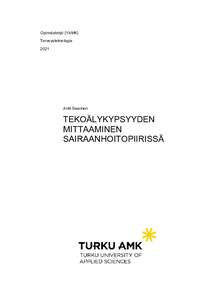Tekoälykypsyyden mittaaminen sairaanhoitopiirissä
Saarinen, Antti (2021)
Saarinen, Antti
2021
All rights reserved. This publication is copyrighted. You may download, display and print it for Your own personal use. Commercial use is prohibited.
Julkaisun pysyvä osoite on
https://urn.fi/URN:NBN:fi:amk-2021121726798
https://urn.fi/URN:NBN:fi:amk-2021121726798
Tiivistelmä
Tekoälykypsyyden mittaaminen suomalaisessa julkisessa terveydenhuollossa on yhteiskunnallisesti ja kansanterveydellisesti ajankohtainen ja olennainen asia, jolle painoarvoa keskeisinä seikkoina antavat maamme jatkuva yhteiskunnallinen rakennemuutos, sosiaali- ja terveydenhuollon valtakunnalliset uudistamispyrkimykset sekä tekoälyhankkeiden toteuttaminen julkisin varoin. Viime vuosina kehitetyt tekoälykypsyysmallit mahdollistavat vertailevan keskustelun tekoälyratkaisujen hyödyntämisen ja kehittämisen mittaamisesta.
Tässä opinnäytetyössä tutkittiin tekoälykypsyyden mittaamista sairaanhoitopiirissä. Tutkimuksessa selvitettiin Varsinais-Suomen sairaanhoitopiirin tekoälykypsyyden mittaamista, nykytilaa ja tulevaisuuden tavoitetilaa. Tutkimusmenetelmänä käytettiin teemahaastattelua. Tutkimuksessa sovellettiin määrämuotoista, tieteellisesti kehitettyä tekoälykypsyysmallia, jota laajennettiin nykytilan arvioimisen lisäksi myös tulevaisuuden tavoitetilan hahmottamiseen. Tutkimuksessa selvitettiin myös tekoälykypsyysmallin soveltuvuutta sairaanhoitopiiriorganisaation tekoälykypsyyden arviointiin.
Tutkimustuloksista havaittiin, että sairaanhoitopiirissä ei organisaatiotasoista tekoälykypsyyttä varsinaisesti mitattu, mutta tekoälystä saatavia hyötyjä arvioitiin toiminnassa. Tutkimustuloksista muodostui selkeä kuva tekoälykypsyyden nykytilasta ja tulevaisuuden tavoitetilasta, johon pääsemiseksi sairaanhoitopiiri kuvasi runsaasti keinoja. Tekoälykypsyyden mittaamisesta tulevaisuudessa esitettiin myös monipuolisia näkemyksiä. Tutkimustuloksista ilmeni, että tekoälyratkaisujen vaikuttavuuden ja tekoälykypsyyden mittaamisen tärkeys ymmärrettiin sairaanhoitopiirissä selkeästi. Tutkimuksessa käytetty tekoälykypsyysmalli havaittiin soveltuvaksi välineeksi sairaanhoitopiirin tekoälykypsyyden arviointiin. From a societal and public health perspective, measuring artificial intelligence (AI) maturity in the Finnish public health care is a topical and central issue emphasized by the ongoing structural changes in the Finnish society, the national reform initiatives of the Finnish social welfare and health care system and the execution of publicly financed AI projects. AI maturity models developed in recent years enable comparative discussions on measuring the utilization and development of AI solutions.
The aim of this thesis was to study the measurement of AI maturity in a hospital district. The research carried out in the thesis incorporated studying the measurement of AI maturity in the hospital district of Southwest Finland whose current and future states of AI maturity were investigated in the process. The research method used was thematic interview. The research utilized a specific and scientifically developed AI maturity model whose scope was extended from evaluating the current states of AI maturity to also assessing the future states of AI maturity. Furthermore, the AI maturity model was evaluated in order to determine its suitability for use in the context of assessing the AI maturity of a hospital district organization.
The research results indicated that the hospital district did not measure its AI maturity strictly on the organizational level but that the utility of AI solutions was, however, evaluated in its operations. The research results provided a clear general picture of the current and future states of AI maturity of the hospital district. Aside from describing numerous measures for attaining the aforementioned future states, the hospital district also presented plenty of views in regard to measuring AI maturity in the future. The research results indicated that the hospital district clearly understood the importance of measuring AI maturity and the effectiveness of AI solutions. The AI maturity model used in the research was confirmed to be a suitable instrument for evaluating the AI maturity of the hospital district.
Tässä opinnäytetyössä tutkittiin tekoälykypsyyden mittaamista sairaanhoitopiirissä. Tutkimuksessa selvitettiin Varsinais-Suomen sairaanhoitopiirin tekoälykypsyyden mittaamista, nykytilaa ja tulevaisuuden tavoitetilaa. Tutkimusmenetelmänä käytettiin teemahaastattelua. Tutkimuksessa sovellettiin määrämuotoista, tieteellisesti kehitettyä tekoälykypsyysmallia, jota laajennettiin nykytilan arvioimisen lisäksi myös tulevaisuuden tavoitetilan hahmottamiseen. Tutkimuksessa selvitettiin myös tekoälykypsyysmallin soveltuvuutta sairaanhoitopiiriorganisaation tekoälykypsyyden arviointiin.
Tutkimustuloksista havaittiin, että sairaanhoitopiirissä ei organisaatiotasoista tekoälykypsyyttä varsinaisesti mitattu, mutta tekoälystä saatavia hyötyjä arvioitiin toiminnassa. Tutkimustuloksista muodostui selkeä kuva tekoälykypsyyden nykytilasta ja tulevaisuuden tavoitetilasta, johon pääsemiseksi sairaanhoitopiiri kuvasi runsaasti keinoja. Tekoälykypsyyden mittaamisesta tulevaisuudessa esitettiin myös monipuolisia näkemyksiä. Tutkimustuloksista ilmeni, että tekoälyratkaisujen vaikuttavuuden ja tekoälykypsyyden mittaamisen tärkeys ymmärrettiin sairaanhoitopiirissä selkeästi. Tutkimuksessa käytetty tekoälykypsyysmalli havaittiin soveltuvaksi välineeksi sairaanhoitopiirin tekoälykypsyyden arviointiin.
The aim of this thesis was to study the measurement of AI maturity in a hospital district. The research carried out in the thesis incorporated studying the measurement of AI maturity in the hospital district of Southwest Finland whose current and future states of AI maturity were investigated in the process. The research method used was thematic interview. The research utilized a specific and scientifically developed AI maturity model whose scope was extended from evaluating the current states of AI maturity to also assessing the future states of AI maturity. Furthermore, the AI maturity model was evaluated in order to determine its suitability for use in the context of assessing the AI maturity of a hospital district organization.
The research results indicated that the hospital district did not measure its AI maturity strictly on the organizational level but that the utility of AI solutions was, however, evaluated in its operations. The research results provided a clear general picture of the current and future states of AI maturity of the hospital district. Aside from describing numerous measures for attaining the aforementioned future states, the hospital district also presented plenty of views in regard to measuring AI maturity in the future. The research results indicated that the hospital district clearly understood the importance of measuring AI maturity and the effectiveness of AI solutions. The AI maturity model used in the research was confirmed to be a suitable instrument for evaluating the AI maturity of the hospital district.
